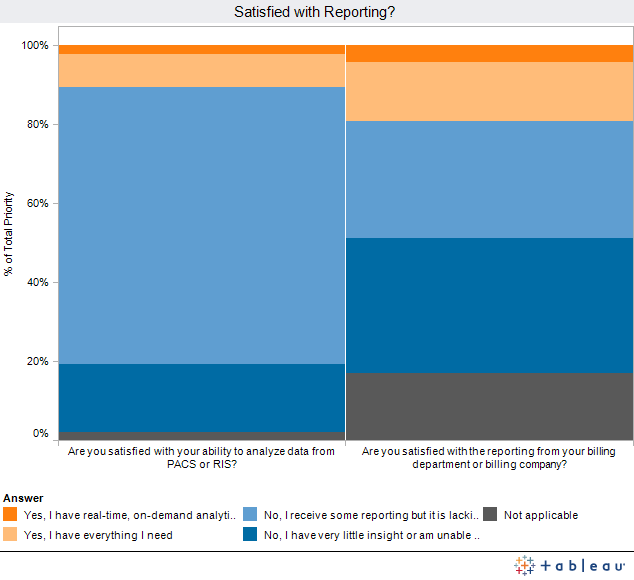Many Not Satisfied with Business Analytics Reporting
A majority of radiologists aren’t satisfied with their RIS/ PACS or billing reporting, our recent survey on business analytics found.
This is the first part in a series analyzing the results of a survey conducted on Diagnostic Imaging regarding use of business analytics in radiology. Part I covers responses on satisfaction with current reporting practices.
Are you satisfied with your ability to analyze data from PACS or RIS?
- 17% - No, I am virtually unable to get data out of their system.
- 70% - No, I can generate some reports, but the process is manual and time consuming
- 9% - Yes, analyzing data is easy, I can generate anything I need
- 2% - Yes, I have real-time, on-demand analytics
- 2% - Not applicable
Are you satisfied with the reporting from your billing department or billing company?
- 34% - No, I have very little insight in billing data
- 30% - No, I receive a reporting package, but it does not provide me enough insight
- 15% - Yes, billing provides periodic reporting that provides me everything I need
- 4% - Yes, I have real-time, on-demand analytics
- 17% - Not applicable
The first surprise for me is how many are not satisfied with their current reporting. Eight-seven percent are not satisfied with their RIS or PACS reporting and64 percent are not satisfied with their billing reporting. (The billing figure rises to 77 percent after excluding not applicable responses from the results) I should have expected that so many people find reporting and access to data so difficult, as it has been a hot topic at recent conferences I have attended for AHRA, RBMA and at RSNA.
Additional interesting findings come from looking closer at those who seem dissatisfied with reporting from their RIS/PACS. Seventy percent are able to get some data from RIS/PACS, but it is time consuming. Based on many personal conversations I have had, I interpret this to mean that nearly three-fourths of RIS/PACS have at least an ability to export data to Excel, where it has to be manipulated to make the data meaningful. Seventeen percent are unable to get virtually any insight, which probably means their software offers no reporting or export capabilities.
Compare the RIS/PACS answers to the responses from billing, where 34 percent get virtually no insight from their billing department or company. In coming to a conclusion on this 34 percent who get very little insight, let’s exclude the assumption that their role would not benefit from billing data - those are represented in the “not applicable” answer (17 percent) One-third of respondent then are getting virtually zero insight from billing.
I interpret this high percentage of respondents who are getting virtually zero insight as a combination of a failure of billing systems and internal politics restricting the information.T he 30 percent who do get a billing package, but that does not meet their needs, likely means that the billing systems are designed to capture the transactions - as do the RIS/PACS - but do a poor job of opening up the data for analysis.
In the second part, I will cover why respondents do not invest in business analytics and how they could utilize better insight from the analytics.
David Fuhriman, MBA, CPA, is CEO of Bern Medical
The Reading Room Podcast: Current Perspectives on the Updated Appropriate Use Criteria for Brain PET
March 18th 2025In a new podcast, Satoshi Minoshima, M.D., Ph.D., and James Williams, Ph.D., share their insights on the recently updated appropriate use criteria for amyloid PET and tau PET in patients with mild cognitive impairment.
Meta-Analysis Shows Merits of AI with CTA Detection of Coronary Artery Stenosis and Calcified Plaque
April 16th 2025Artificial intelligence demonstrated higher AUC, sensitivity, and specificity than radiologists for detecting coronary artery stenosis > 50 percent on computed tomography angiography (CTA), according to a new 17-study meta-analysis.
